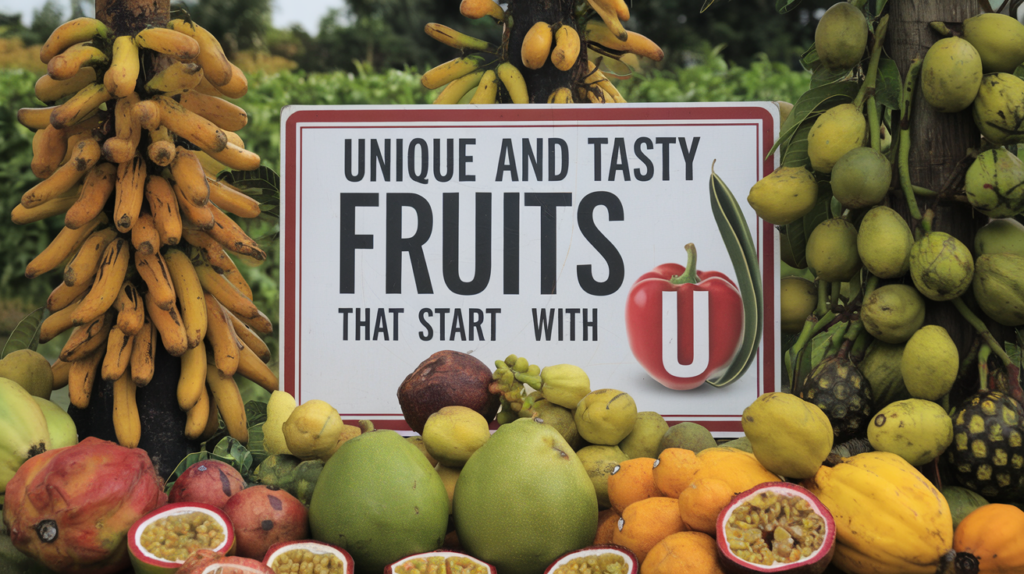Ever wondered about fruits beyond the usual apples and bananas? This blog digs into something different today – fruits that start with the letter U.
Yes, they exist! These underrated gems are hiding in plain sight, waiting to be located in markets and gardens around the world.
Some might sound familiar to readers, others completely foreign to their ears.
But that’s the fun part, isn’t it? Looking out for the unknown.
From the sweet ugni to the tangy ugli fruit, these U-treasures bring unique flavors and nutrients to the plate.
So grab a cup of tea, get comfy, and join this little odyssey as we unearth the mysterious world of U-fruits. Your taste buds will thank you later!
Delicious U-Fruits You Need to Try
1. Ugli Fruit

Ugli fruit is a Jamaican citrus hybrid fruit which is part orange, grapefruit, and tangerine. Its rough, wrinkled skin hides a juicy, tangy-sweet interior that’s rich in vitamin C and perfect for juicing or snacking.
Nutritional Value Per 100g:
- Calories: 47cal
- Fat: 0.2g
- Sodium: 1mg
- Carbohydrates: 11.2g
- Fiber: 2g
- Sugar: 8g
- Protein: 0.9g
| Attribute | Information |
|---|---|
| Scientific Name | Citrus reticulata × Citrus paradisi |
| Harvesting Season | Winter to early spring |
| Growing Conditions | Tropical climate, well-drained soil |
| Culinary Uses | Fresh, juices, salads, marmalade |
| Popular Regions | Jamaica, United States, Caribbean |
Fun Fact: The name “Ugli” comes from its unattractive appearance, but the taste is amazing.
2. Ububese (Dwarf Custard Apple)

Ububese is a wild African fruit with a creamy, sweet flavor similar to custard. It has soft, edible pulp and is often enjoyed fresh or made into beverages.
Nutritional Value Per 100g:
- Calories: 75cal
- Fat: 0.6g
- Sodium: 2mg
- Carbohydrates: 18g
- Fiber: 2.2g
- Sugar: 15g
- Protein: 1g
| Attribute | Information |
|---|---|
| Scientific Name | Annona senegalensis |
| Harvesting Season | Late summer to autumn |
| Growing Conditions | Dry savanna, sandy soil |
| Culinary Uses | Eaten raw, juices, traditional brews |
| Popular Regions | Sub-Saharan Africa |
Fun Fact: Ububese is not only tasty but it’s also used in traditional African medicine for its soothing properties.
3. Uva (Grape in Spanish)

Uva refers to grapes in Spanish. These juicy, bite-sized fruits come in many varieties and are used for wine-making, eating fresh, and drying into raisins.
Nutritional Value Per 100g:
- Calories: 69cal
- Fat: 0.2g
- Sodium: 2mg
- Carbohydrates: 18g
- Fiber: 0.9g
- Sugar: 15g
- Protein: 0.7g
| Attribute | Information |
|---|---|
| Scientific Name | Vitis vinifera |
| Harvesting Season | Late summer to early fall |
| Growing Conditions | Temperate climate, loamy soil |
| Culinary Uses | Fresh, wine, raisins, jams |
| Popular Regions | Spain, Italy, USA, Chile |
Fun Fact: Spain is one of the largest producers of grapes in the world, with over 400 grape varieties!
4. Ume (Japanese Plum)

Ume is a small, tart fruit used in East Asian cuisine. It’s commonly pickled into “umeboshi” or turned into syrup, jam, and even wine.
Nutritional Value Per 100g:
- Calories: 30cal
- Fat: 0.1g
- Sodium: 3mg
- Carbohydrates: 8g
- Fiber: 2.2g
- Sugar: 5g
- Protein: 0.3g
| Attribute | Information |
|---|---|
| Scientific Name | Prunus mume |
| Harvesting Season | Late spring |
| Growing Conditions | Mild winters, well-drained soil |
| Culinary Uses | Pickled, syrups, liqueurs, sauces |
| Popular Regions | Japan, China, Korea |
Fun Fact: Umeboshi (pickled ume) is traditionally eaten to aid digestion and is often tucked inside Japanese rice balls.
5. Uvilla (Goldenberry)

Uvilla, also called goldenberry or Physalis, is a bright yellow-orange fruit encased in a papery husk. It has a tangy-sweet flavor and is packed with antioxidants.
Nutritional Value Per 100g:
- Calories: 53cal
- Fat: 0.7g
- Sodium: 1mg
- Carbohydrates: 11g
- Fiber: 4.9g
- Sugar: 6.8g
- Protein: 1.9g
| Attribute | Information |
|---|---|
| Scientific Name | Physalis peruviana |
| Harvesting Season | Mid-summer to early fall |
| Growing Conditions | Warm climates, well-drained sandy soil |
| Culinary Uses | Fresh, jams, salads, desserts |
| Popular Regions | Colombia, Ecuador, Peru, South Africa |
Fun Fact: Uvilla is considered a superfood in South America due to its high vitamin A and antioxidant content.
6. Umbu

Native to Brazil, the Umbu fruit is juicy, tart, and refreshingly tangy. Often made into jams, jellies, and beverages, it thrives in dry, arid conditions.
Nutritional Value Per 100g:
- Calories: 41cal
- Fat: 0.3g
- Sodium: 1mg
- Carbohydrates: 10g
- Fiber: 2.6g
- Sugar: 7g
- Protein: 0.6g
| Attribute | Information |
|---|---|
| Scientific Name | Spondias tuberosa |
| Harvesting Season | Late summer to early autumn |
| Growing Conditions | Arid, semi-arid regions, deep roots |
| Culinary Uses | Juices, jams, compotes |
| Popular Regions | Northeastern Brazil |
Fun Fact: Umbu means “tree that gives drink” in the Tupi language because of its juicy pulp.
7. Umbra Fruit (Ambarella)

Also known as ambarella, umbra fruit is green, tart, and crunchy when unripe, turning sweet as it matures. It’s often eaten raw, pickled, or juiced.
Nutritional Value Per 100g:
- Calories: 42cal
- Fat: 0.3g
- Sodium: 2mg
- Carbohydrates: 10g
- Fiber: 3g
- Sugar: 8g
- Protein: 0.9g
| Attribute | Information |
|---|---|
| Scientific Name | Spondias dulcis |
| Harvesting Season | Late summer to early winter |
| Growing Conditions | Tropical, humid climates |
| Culinary Uses | Fresh, pickled, juices, chutneys |
| Popular Regions | Southeast Asia, Caribbean, Polynesia |
Fun Fact: In some cultures, ambarella leaves are also eaten and used in traditional medicine.
8. Urava Fruit (Mangrove Apple)

Urava fruit grows on mangrove trees and is astringent with a mildly sweet core. It’s often used in pickles and traditional remedies.
Nutritional Value Per 100g:
- Calories: 38cal
- Fat: 0.4g
- Sodium: 3mg
- Carbohydrates: 9g
- Fiber: 2.7g
- Sugar: 4.5g
- Protein: 0.5g
| Attribute | Information |
|---|---|
| Scientific Name | Sonneratia alba |
| Harvesting Season | Late monsoon |
| Growing Conditions | Coastal, saline soils |
| Culinary Uses | Pickles, pastes, folk medicine |
| Popular Regions | Southeast Asia, South India, Maldives |
Fun Fact: The tree’s roots help prevent coastal erosion, making this fruit a part of both nature and culture.
9. Upland Cress Fruit

Though often used as a leafy green, upland cress produces small edible seed pods considered fruit-like in some culinary traditions, with a peppery bite.
Nutritional Value Per 100g:
- Calories: 32cal
- Fat: 0.3g
- Sodium: 4mg
- Carbohydrates: 6g
- Fiber: 2g
- Sugar: 1.5g
- Protein: 2.1g
| Attribute | Information |
|---|---|
| Scientific Name | Barbarea verna |
| Harvesting Season | Spring and autumn |
| Growing Conditions | Cool, moist, well-drained soil |
| Culinary Uses | Salads, garnishes, sauces |
| Popular Regions | United States, UK, New Zealand |
Fun Fact: Upland cress was once a staple in early American kitchens for its spicy flavor and quick growth.
10. Ucuuba Fruit

Native to the Amazon rainforest, Ucuuba is a small red fruit with oily seeds used more for its butter than its pulp. The fruit is mildly sweet and consumed locally.
Nutritional Value Per 100g:
- Calories: 90cal
- Fat: 3g
- Sodium: 2mg
- Carbohydrates: 18g
- Fiber: 1.5g
- Sugar: 12g
- Protein: 0.9g
| Attribute | Information |
|---|---|
| Scientific Name | Virola surinamensis |
| Harvesting Season | Late summer |
| Growing Conditions | Humid, tropical rainforests |
| Culinary Uses | Traditional snacks, cosmetics (seeds) |
| Popular Regions | Brazil, Peru, Colombia |
Fun Fact: Ucuuba butter is used in natural skincare products for its moisturizing properties.
11. Uapaca Kirkiana (Wild Loquat)

This fruit has a sweet, tangy pulp with a custard-like texture. Native to southern Africa, it grows in the wild and is prized for its unique taste.
Nutritional Value Per 100g:
- Calories: 65cal
- Fat: 0.4g
- Sodium: 1mg
- Carbohydrates: 16g
- Fiber: 3g
- Sugar: 12g
- Protein: 1.1g
| Attribute | Information |
|---|---|
| Scientific Name | Uapaca kirkiana |
| Harvesting Season | Late winter to spring |
| Growing Conditions | Woodlands, sandy soil |
| Culinary Uses | Juices, jams, fermented drinks |
| Popular Regions | Zimbabwe, Malawi, Mozambique |
Fun Fact: The tree is often called the “mashuku tree,” and its fruits are collected by children during harvest festivals.
12. Upland Tomato

Not a separate species, but a regional name for hardy tomato varieties grown in upland climates. Often smaller, these tomatoes are rich in flavor and acidity.
Nutritional Value Per 100g:
- Calories: 18cal
- Fat: 0.2g
- Sodium: 5mg
- Carbohydrates: 3.9g
- Fiber: 1.2g
- Sugar: 2.6g
- Protein: 0.9g
| Attribute | Information |
|---|---|
| Scientific Name | Solanum lycopersicum |
| Harvesting Season | Summer to early fall |
| Growing Conditions | Cool climates, rich soil |
| Culinary Uses | Salads, sauces, soups, roasting |
| Popular Regions | Andes, East Africa, Southeast Asia |
Fun Fact: Upland tomatoes are preferred for sun-drying because of their low moisture and high acidity.
13. Umari Fruit

Umari is a tropical fruit with creamy yellow pulp and a strong, cheese-like smell. It’s often cooked or fermented before consumption.
Nutritional Value Per 100g:
- Calories: 120cal
- Fat: 5g
- Sodium: 2mg
- Carbohydrates: 15g
- Fiber: 2g
- Sugar: 9g
- Protein: 1.2g
| Attribute | Information |
|---|---|
| Scientific Name | Poraqueiba sericea |
| Harvesting Season | Spring to early summer |
| Growing Conditions | Tropical forests, moist conditions |
| Culinary Uses | Cooked pulp, fermented drinks |
| Popular Regions | Brazil, Colombia, Venezuela |
Fun Fact: Despite its odd smell, Umari is loved locally and often paired with cassava or fish dishes.
14. Ugandan Gooseberry

A wild variety of gooseberry found in Uganda, this fruit is small, round, and slightly bitter with a citrusy tang. It’s used in sauces and traditional dishes.
Nutritional Value Per 100g:
- Calories: 44cal
- Fat: 0.6g
- Sodium: 1mg
- Carbohydrates: 10g
- Fiber: 3.1g
- Sugar: 7g
- Protein: 0.8g
| Attribute | Information |
|---|---|
| Scientific Name | Physalis angulata |
| Harvesting Season | Spring to summer |
| Growing Conditions | Wild fields, moderate rainfall |
| Culinary Uses | Curries, sauces, preserves |
| Popular Regions | Uganda, Kenya, Tanzania |
Fun Fact: In Ugandan herbal medicine, this gooseberry is used for its supposed anti-inflammatory properties.
15. Uvalino Grape

Uvalino is an ancient Italian grape variety known for its dark purple color and resilience. It’s primarily used in wine production and has high polyphenol content.
Nutritional Value Per 100g:
- Calories: 70cal
- Fat: 0.2g
- Sodium: 1mg
- Carbohydrates: 18g
- Fiber: 1.1g
- Sugar: 15g
- Protein: 0.6g
| Attribute | Information |
|---|---|
| Scientific Name | Vitis vinifera ‘Uvalino’ |
| Harvesting Season | Early fall |
| Growing Conditions | Sunny hillsides, Mediterranean soil |
| Culinary Uses | Winemaking |
| Popular Regions | Italy (Piedmont) |
Fun Fact: Uvalino grapes almost went extinct but were revived for their exceptional antioxidant properties.
16. Umeboshi (Pickled Ume)

Umeboshi are intensely salty and sour pickled plums, made from ume fruit. They’re a staple in Japanese cuisine and used as a condiment or eaten with rice.
Nutritional Value Per 100g:
- Calories: 33cal
- Fat: 0.2g
- Sodium: 870mg
- Carbohydrates: 9g
- Fiber: 2g
- Sugar: 3g
- Protein: 0.9g
| Attribute | Information |
|---|---|
| Scientific Name | Prunus mume |
| Harvesting Season | Summer (pickled post-harvest) |
| Growing Conditions | Temperate climate, hilly terrain |
| Culinary Uses | Rice balls, sauces, seasoning |
| Popular Regions | Japan, Korea, Taiwan |
Fun Fact: Umeboshi are considered a natural hangover cure and digestion aid in Japan.
17. Ulena (South African Berry)

Ulena is a small native berry in parts of Southern Africa. Slightly tart and rich in antioxidants, it’s foraged and sometimes fermented or dried.
Nutritional Value Per 100g:
- Calories: 58cal
- Fat: 0.4g
- Sodium: 1mg
- Carbohydrates: 13g
- Fiber: 3g
- Sugar: 8g
- Protein: 1g
| Attribute | Information |
|---|---|
| Scientific Name | Not widely recorded |
| Harvesting Season | Late summer |
| Growing Conditions | Dry grasslands, wild shrubs |
| Culinary Uses | Snacks, local wines, dried fruit |
| Popular Regions | South Africa, Namibia, Botswana |
Fun Fact: Ulena is often used in traditional ceremonies as a fermented drink base.
18. Umi-budō (Sea Grapes)

Also called green caviar, umi-budō is an edible seaweed with tiny, grape-like bubbles. It’s popular in Japanese and Okinawan cuisine for its salty pop and nutritional benefits.
Nutritional Value Per 100g:
- Calories: 15cal
- Fat: 0.1g
- Sodium: 240mg
- Carbohydrates: 3g
- Fiber: 1.8g
- Sugar: 0g
- Protein: 1g
| Attribute | Information |
|---|---|
| Scientific Name | Caulerpa lentillifera |
| Harvesting Season | Year-round (cultivated) |
| Growing Conditions | Coastal seawater farms, warm waters |
| Culinary Uses | Salads, soy sauce dips, sushi garnish |
| Popular Regions | Japan, Philippines, Vietnam |
Fun Fact: Umi-budō is nicknamed “longevity seaweed” for its role in Okinawan centenarian diets.
19. Udara (African Star Apple)

Udara is a juicy, sweet-sour tropical fruit popular in West Africa. It has a sticky latex-like pulp and is cherished for its vitamin-rich content.
Nutritional Value Per 100g:
- Calories: 67cal
- Fat: 0.5g
- Sodium: 2mg
- Carbohydrates: 15g
- Fiber: 2.7g
- Sugar: 11g
- Protein: 1.1g
| Attribute | Information |
|---|---|
| Scientific Name | Chrysophyllum albidum |
| Harvesting Season | December to April |
| Growing Conditions | Tropical climate, loamy soil |
| Culinary Uses | Eaten fresh, local desserts |
| Popular Regions | Nigeria, Ghana, Cameroon |
Fun Fact: In Nigeria, it’s considered a childhood favorite and often eaten right off the tree.
20. Upland Ground Cherry

This small, husk-covered fruit is a wild cousin of the goldenberry. It has a tart flavor and is often foraged in high-altitude areas.
Nutritional Value Per 100g:
- Calories: 55cal
- Fat: 0.5g
- Sodium: 1mg
- Carbohydrates: 12g
- Fiber: 2.2g
- Sugar: 8g
- Protein: 1.3g
| Attribute | Information |
|---|---|
| Scientific Name | Physalis longifolia |
| Harvesting Season | Late summer to early fall |
| Growing Conditions | High altitudes, dry grasslands |
| Culinary Uses | Fresh, pies, sauces, preserves |
| Popular Regions | Western US, Mexico, Guatemala |
Fun Fact: Native American tribes traditionally used this fruit for both food and medicine.
21. Uvaria rufa (Sussuba)

Uvaria rufa, often called sussuba or hairy fruit, is a small, reddish-orange fruit found in Southeast Asia. It has soft, aromatic pulp with a tangy-sweet taste, often enjoyed raw.
Nutritional Value Per 100g:
- Calories: 58cal
- Fat: 0.4g
- Sodium: 1mg
- Carbohydrates: 13g
- Fiber: 2.1g
- Sugar: 9g
- Protein: 1g
| Attribute | Information |
|---|---|
| Scientific Name | Uvaria rufa |
| Harvesting Season | Late summer |
| Growing Conditions | Tropical forests, humid soil |
| Culinary Uses | Fresh, jams, local treats |
| Popular Regions | Philippines, Thailand, Malaysia |
Fun Fact: Its striking red outer skin is covered in soft hairs, giving it a fuzzy, exotic appearance.
22. Uvaria grandiflora

This wild fruit is native to tropical Asia and is known for its large, fragrant flowers and deep purple fruits. The flavor is mildly sweet and often compared to bananas or custard.
Nutritional Value Per 100g:
- Calories: 62cal
- Fat: 0.3g
- Sodium: 2mg
- Carbohydrates: 14g
- Fiber: 2.8g
- Sugar: 9.5g
- Protein: 0.9g
| Attribute | Information |
|---|---|
| Scientific Name | Uvaria grandiflora |
| Harvesting Season | Spring |
| Growing Conditions | Rainforests, well-drained soil |
| Culinary Uses | Fresh, fermented beverages |
| Popular Regions | Southeast Asia, Sri Lanka, India |
Fun Fact: The tree is also prized for its ornamental value due to its large, showy flowers.
Additional Exotic Fruits with The Letter U
23. Uvalha (Brazilian Fruit)
Uvalha is a native Brazilian fruit with vibrant yellow-orange skin and a citrusy, slightly sour taste. It’s rich in vitamin C and is commonly used in homemade juices and jams.
24. Urui (Hosta Shoots)
Urui refers to the tender young shoots of the hosta plant in Japan, treated like a fruit or vegetable. They have a mild, slightly sweet flavor and are often eaten raw or steamed.
25. Uncaria tomentosa (Cat’s Claw Fruit)
Though better known for its bark, Uncaria tomentosa produces small, dry fruits. These aren’t eaten raw but are processed for herbal and medicinal purposes in South America.
26. Unona Fruit (Custard Apple Relative)
Unona is an older name for certain species in the Annona family. Its fruit resembles a custard apple—soft, sweet, and fragrant—with white to pale yellow pulp.
27. Ulawa Fruit (Solomon Islands)
Ulawa is a local term for a native fruit found on Ulawa Island in the Solomon Islands. It’s small, tropical, and often foraged by hand.
28. Uliuli Berry
The uliuli berry is a Hawaiian wild fruit with deep purple skin and a tart, juicy center. It’s typically found in upland forests and used in traditional food and dyes.
29. Umbu-cajá
Umbu-cajá is a hybrid fruit from Brazil—a cross between umbu and cajá. It combines tangy and sweet flavors, making it perfect for juices and sorbets.
30. Ucuhuba (Amazon Fruit)
Ucuhuba produces small fruits, but it’s more valued for its seeds, which yield a rich butter used in skin care. The fruit itself has bitter pulp and is sometimes fermented.
31. Urucu (Achiote Fruit)
Though better known for its seeds used in annatto coloring, the Urucu fruit itself is prickly and reddish, housing bright orange seeds used in cooking and cosmetics.
32. Upland Fig
A term used for wild fig varieties found in hilly or mountainous regions. These figs are smaller, with an intense, sweet flavor and thick skin.
33. Ugo Fruit (Papua New Guinea)
Ugo is a local name for a small, orange-red fruit found in Papua New Guinea. It has a slightly sour flavor and is often eaten fresh or made into local sauces.
34. Upland Jujube
A hardy variety of jujube grown in highland regions, this fruit is small and sweet with a chewy texture, often dried or eaten fresh.
35. Urupe (Amazon Fruit)
Urupe is a native Amazon fruit with a tangy taste and soft pulp. It’s used locally in beverages, snacks, and traditional remedies.
36. Ulama Fruit
A rare tropical fruit found in parts of the Pacific, Ulama is sweet with a creamy texture. It’s typically foraged and not commercially cultivated.
37. Ulala Berry
Ulala berry is a small, dark-purple fruit native to the Andes. It has a rich, berry-like flavor and is often used in teas and preserves.
38. Uveta (Spanish Dialect for Raisin)
Uveta is a regional Spanish term for raisins—dried grapes rich in natural sugars and fiber, commonly used in baking and snacking.
39. Uru Fruit (Breadfruit)
Known as Uru in Polynesian cultures, breadfruit is large and starchy, often roasted, boiled, or baked. It’s a staple carbohydrate in tropical island diets.
40. Uncha Fruit (Mythical Term)
“Uncha” is a fictional or poetic name used in folk tales to describe a rare, elusive fruit of great value. It symbolizes hidden wisdom or love.
41. Usuma (Peanut Butter Fruit)
This small, red-orange fruit tastes remarkably like peanut butter. Soft and sweet, it’s eaten raw or made into milkshakes and desserts.
42. Ubajay (South American Cherry)
Ubajay is a native fruit of South America with an apricot-like color and tangy-sweet flavor. It’s used in jellies, juices, and eaten fresh.
43. Urapa Fruit
A native Amazonian fruit, Urapa is small and reddish, with a fibrous texture and earthy flavor. It’s commonly used in indigenous medicine.
44. Uvalha do Campo
A wild version of the Uvalha, this fruit grows in grasslands and has a stronger sour taste. It’s mainly used in fermented drinks and rustic cooking.
45. Urumbe Fruit
Known locally in East Africa, Urumbe is a small fruit with bitter skin and sweet pulp. It’s eaten raw or dried and used in spiced sauces.
46. Ule Tree Fruit
The Ule tree bears round, greenish fruits with a sticky sap. While the fruit is mildly sweet, the sap is historically used for rubber extraction.
47. Ubube Berry
Ubube is a traditional name for a small, tart berry found in parts of Southern Africa. It’s often sun-dried and added to porridges or breads.
48. Utobo Fruit
Utobo is a tropical fruit with red-orange skin and citrusy pulp. It is rare and usually consumed fresh or as part of local festive dishes.
49. Ubaia
Ubaia is a native Brazilian fruit that is soft, orange, and intensely sweet. It’s not widely commercialized but beloved in rural communities.
50. Uçáuba (Amazonian Variant)
Uçáuba is a regional spelling for Ucuuba, found deeper in Amazonian territory. Fruits are bitter but valued for their oil-rich seeds.
51. Urupá Fruit
Native to Brazil’s interior, Urupá is a sour-tasting fruit used in rustic cooking. It’s most often found growing wild and collected for preserves.
52. Ugniberry (Chilean Guava)
Ugniberry, also known as Chilean guava or strawberry myrtle, is a small, red fruit with a sweet, aromatic flavor reminiscent of strawberries and bubblegum.
53. Urétí (Local Pacific Island Fruit)
Urétí is a native Polynesian fruit similar to a fig or berry. It grows in dense clusters and has a mildly sweet and nutty taste, often eaten by foraging communities.
54. Ube Kinampay (Philippine Tuber Fruit Variant)
Ube Kinampay is a prized variety of ube from Bohol, Philippines. While technically a yam, it’s considered a culinary fruit due to its rich, sweet flavor and use in desserts.
55. Ucini Fruit (Southeast Asia)
Ucini is a lesser-known fruit found in forested regions of Southeast Asia. It has a thin, greenish-yellow skin and tart pulp, often used in sour relishes.
56. Udu Fruit (South Indian Wild Fruit)
Udu is a tiny wild fruit native to parts of South India. It’s reddish-black when ripe and has a sweet-tart taste, often eaten by children directly from the tree.
57. Umbi-Umbi Fruit (Pacific Island Creeper)
Umbi-umbi is a climbing plant bearing small yellow fruits with mildly sweet pulp. The fruit is chewy, and the vine is used to make medicinal teas.
58. Ubo Fruit (East African Forests)
Ubo is a native fruit of East Africa, found in shaded woodland areas. It has a bitter skin but sweet pulp, used to make rustic fruit leathers.
Recipes Using Fruits That Start with U
Looking to get creative with fruits that start with the letter “U”?
These easy, flavorful recipes showcase the versatility of unique fruits like Ugli, Ube, and Uvilla. Regardless of if you are craving something sweet, tangy, or tropical, there’s a U-powered treat here for you.
1. Ugli Fruit Citrus Salad

A vibrant, zesty salad featuring the juicy tang of Ugli fruit combined with fresh herbs and a honey-lime dressing.
Ingredients:
- 2 Ugli fruits, peeled and segmented
- 1 orange, peeled and segmented
- 1 grapefruit, peeled and segmented
- 1 tbsp chopped mint
- 2 tbsp honey
- 1 tbsp lime juice
Instructions:
- Supreme the Ugli fruits, orange, and grapefruit by cutting away the peel and pith, then carefully slice between the membranes to release clean segments into a bowl, catching any juice.
- In a small saucepan, gently warm the honey with the lime juice until just combined and slightly thinned, about 1 minute. Allow to cool to room temperature.
- Arrange the citrus segments decoratively on a serving platter, alternating colors for visual appeal.
- Drizzle the honey-lime dressing over the arranged fruit.
- Tear the mint leaves rather than chopping them to release more aromatics, and scatter over the salad just before serving.
- Let the salad rest for 10 minutes at room temperature before serving to allow flavors to meld.
2. Uvilla Jam

A sweet-tart preserve made from goldenberry (Uvilla), perfect for spreading on toast or pairing with cheese.
Ingredients:
- 2 cups fresh Uvilla (goldenberries), husked
- 3/4 cup sugar
- 1 tbsp lemon juice
- 1/4 tsp cinnamon (optional)
Instructions:
- Place the husked Uvillas in a bowl and lightly crush about half of them with a fork to release juices while leaving some whole for texture.
- Combine the crushed and whole Uvillas with sugar in a bowl, cover, and let macerate in the refrigerator for at least 4 hours or overnight to draw out natural juices and intensify flavor.
- Transfer the macerated Uvilla mixture to a wide, heavy-bottomed saucepan and add lemon juice.
- Bring to a gentle simmer over medium-low heat, stirring frequently to prevent scorching.
- Once simmering, reduce heat to low and cook uncovered for 30-35 minutes, stirring occasionally, until the mixture thickens and reaches a jam-like consistency.
- Test for doneness by placing a small amount on a chilled plate – it should wrinkle slightly when pushed with your finger.
- For those who prefer cinnamon, toast the ground cinnamon in a dry pan for 30 seconds before stirring into the jam during the last 5 minutes of cooking to improve its aroma.
- Remove from heat and let cool for 10 minutes before transferring to sterilized jars.
- Seal and process in a water bath for 10 minutes for longer shelf storage, or refrigerate for up to 3 weeks.
Conclusion
As our quest through the alphabet’s most underrated letter comes to a close, it’s clear that U-fruits deserve more recognition in our daily diets.
These uncommon treasures offer not just exotic flavors but impressive nutritional profiles that can improve overall wellness.
Next time you’re browsing the produce section or exploring a farmers market, keep an eye out for these unique offerings.
Branch out from the familiar and taste something new – whether it’s the refreshing ugni berries or the peculiar ugli fruit.
The world of U-fruits might be small, but it’s certainly mighty. And remember, culinary affairs begin when we step outside our comfort zones.
Happy fruit hunting, and may your kitchen be forever enriched by these underappreciated botanical wonders!
















